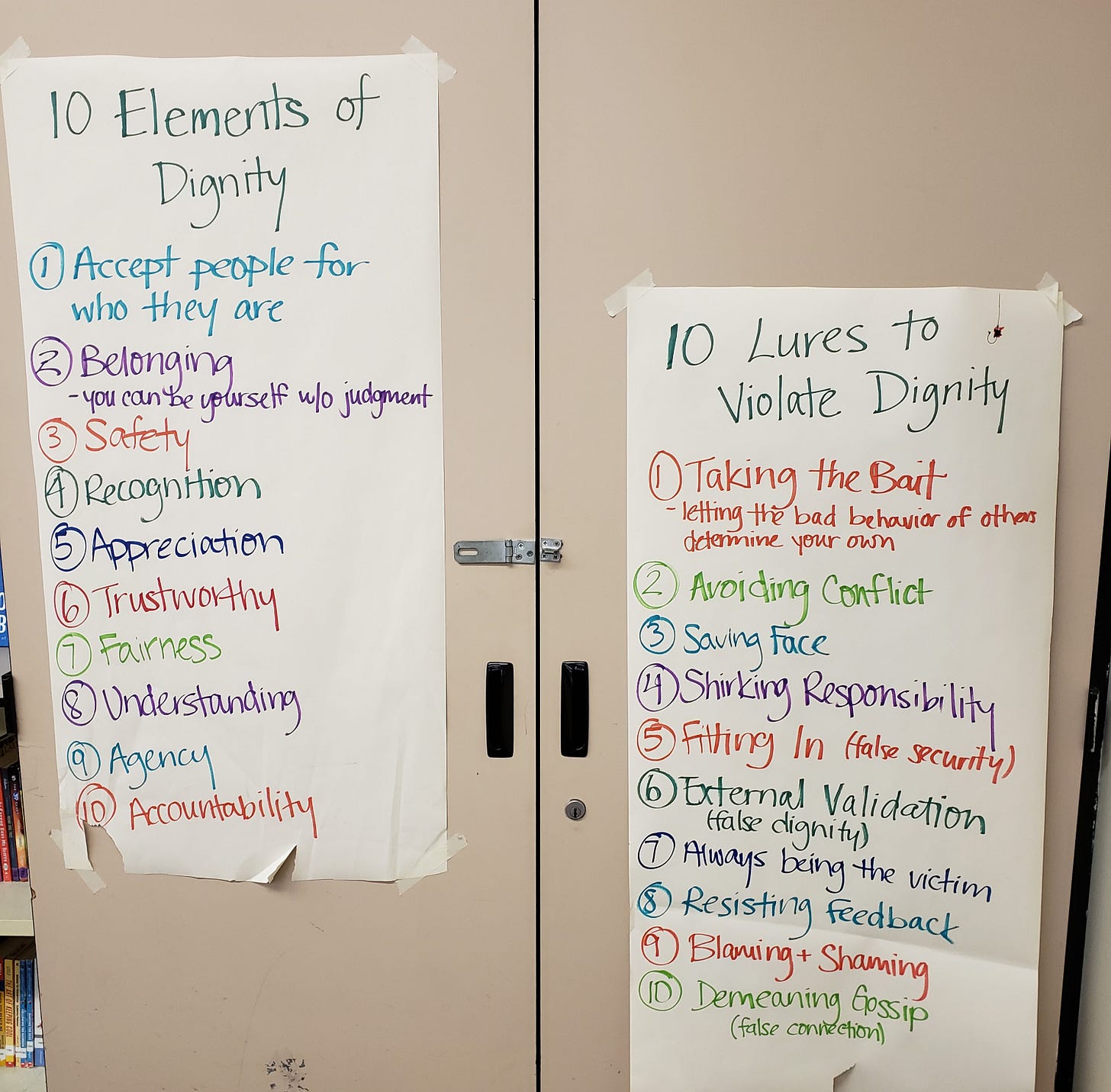What I’m Doing Differently in the Classroom, Part III
Classroom Value: “Treat Everyone with Dignity”
We share a longing for dignity - the feeling of inherent value and worth. When we feel worthy, when our value is recognized, we are content. When a mutual sense of worth is recognized and honored in our relationships, we are connected. A mutual sense of worth also provides the safety necessary for both parties to extend themselves, making continued growth and development possible.
- Dr. Donna Hicks
Previously in my classroom teaching, I haven't had an explicit “classroom value” beyond the school-wide values. This year, I decided to change that, and I wanted it to be easy to remember. As last school year was coming to a close, a co-worker/friend gave me a handout she’d come across called “From Conflict to Conversation.”. Part of the material included “elements of dignity,” and when I saw that description, I knew that I had found my classroom value for the coming year - “Treat Each Other with Dignity.”
I did some reading throughout the summer in preparation, namely the book Dignity: The Essential Role It Plays in Resolving Conflict by Dr. Donna Hicks, which was the source material for the handout’s “elements of dignity”. As I studied and learned more deeply, I decided that in addition to instilling the classroom value,we would learn about dignity through class meetings during the year.
I recognized that the concept of dignity would be unfamiliar to most if not all of my students, so I spent time in the first 4-6 weeks this school year explicitly teaching some of the foundational ideas. (We were also practicing various elements of dignity in these first weeks , the students just didn’t know it yet.) I shared the student-friendly definition of dignity with the classroom: the value and worth that every human is born with. We talked about how, since we’re all born with dignity, it doesn’t have to be earned and it can’t truly be taken away. Our dignity, however, can be damaged or violated. (Side note: I could tell the students understood this concept almost immediately. For weeks, students would yell out in class, “They’re violating my dignity!” while pointing at the guilty party. Pretty much every time, they were accurate in identifying the dignity violation. However, the yelling caused other issues and isn’t a particularly productive path forward. As a result, I ended up introducing conflict resolution strategies sooner than I had anticipated.)
We also talked about how it’s possible to both honor and violate the dignity of each other and ourselves. In order to honor dignity, we need to actually take action (not just think positive thoughts) that demonstrate we see the value in a particular person or group. As Dr. Donna Hicks writes, “Although dignity is part of our human inheritance, knowing how to nurture it is not.”1 Dignity violations can be both verbal and nonverbal and end up causing and/or continuing conflict. We need to learn to identify and manage our emotional reactions to dignity violations so our reactions don’t control us. In doing so, we can better honor our own dignity and the dignity of those around us.
Once we had a foundational understanding of dignity, we spent most of the year moving from merely talking about dignity to practicing “treating each other with dignity” with purposeful activities and conversations. These practices fell into four main categories:
Honoring our own dignity
Honoring the dignity of each other by building a sense of belonging and community
Practicing listening exercises (class meetings are primarily a time for listening)
Practicing conflict resolution strategies
The following are some samples of what we’ve done in each category along with the applicable element of dignity and/or lure to violate in parentheses:
Honoring our own dignity:
Students share answers to one or both of these questions: What’s something you’re proud of about yourself? and/or What are things you’re good at? (Element: Acceptance of identity)
I read aloud the Caldecott award-winner Big by Vashti Harrison, and we did an activity that honored our own dignity even when others have hurt us, modeling the example of the girl who “gives the words back” in the book. (Element: Agency; Lure: False dignity)
Honoring the dignity of each other:
Monthly, we share shout-outs where students essentially give each other compliments (but shout-outs are “cooler” for middle schoolers). (Element: Recognition)
We talk about the differences between belonging and fitting in (Lure: Seeking false security) and how to extend welcome and belonging to everyone around us.
Practicing listening exercises:
For an entry task, students will write to a prompt, e.g. “describe a time when…” then share it with their table partner. Partners are in-turn responsible for sharing the story that they heard. (Element: Acknowledgement)
As a final round/question, students will share, “Something I heard ______ say is…” (Element: Acknowledgement)
Practicing conflict resolution strategies:
We practice the “Bugs & Wishes” strategy where students share, “It bugs me when people…, and I wish they would…”It’s a way to share a complaint and make a request instead of escalating the conflict (Lure: Taking the bait) or avoiding saying anything (Lure: Avoiding conflict).
With some practice scenarios, students can often come up with responses that are constructive/lead to resolution instead of destructive/continuing conflict (Lure: Taking the bait). We then discuss why having a constructive response in the moment is so challenging.
In what ways do you ”treat each other with dignity”?
Have something to share but don’t want to leave a comment? You can email me by replying to this email or DM me on Substack. I’d love to hear from you!
In case you missed it - related essays from Cultivating Justice:
Hicks, D. (2021). Dignity: Its essential role in resolving conflict. Yale University Press. pp. 18









